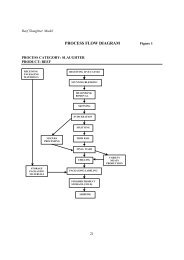Write down what went wrong and what you did about it in your diary.
Write down what went wrong and what you did about it in your diary.
Write down what went wrong and what you did about it in your diary.
Create successful ePaper yourself
Turn your PDF publications into a flip-book with our unique Google optimized e-Paper software.
Safe method:Clean<strong>in</strong>g effectivelyEffective clean<strong>in</strong>g is essential to get rid ofharmful bacteria <strong>and</strong> stop them spread<strong>in</strong>g.Safety po<strong>in</strong>tFollow the manufacturer’s <strong>in</strong>structionson how to use clean<strong>in</strong>g chemicals.Why?This is important to make sure that chemicals work effectively.If <strong>you</strong> have manufacturer’s clean<strong>in</strong>g<strong>in</strong>structions for a piece of equipment,follow these.Wash work surfaces <strong>and</strong> equipmentthoroughly between tasks. Wash <strong>and</strong>dis<strong>in</strong>fect them after prepar<strong>in</strong>g rawmeat/poultry or eggs. See the ‘Clear<strong>and</strong> clean as <strong>you</strong> go’ safe method.The <strong>in</strong>structions will tell <strong>you</strong> howto clean this particular piece ofequipment thoroughly.This will help prevent dirt <strong>and</strong> bacteriaspread<strong>in</strong>g onto other foods from thesurface or equipment.High-prior<strong>it</strong>y clean<strong>in</strong>gRegularly wash/wipe <strong>and</strong> dis<strong>in</strong>fect allthe <strong>it</strong>ems people touch frequently,such as work surfaces, s<strong>in</strong>ks, taps, doorh<strong>and</strong>les, sw<strong>it</strong>ches <strong>and</strong> can openers.Where possible, allow these to drynaturally at the end of each day/shift.Wash <strong>and</strong> dis<strong>in</strong>fect fridges regularlyat a time when they do not conta<strong>in</strong>much food. Transfer food to anotherfridge or a safe cold area <strong>and</strong> keep<strong>it</strong> covered.Pay special attention to how often<strong>you</strong> clean pieces of equipment thathave mov<strong>in</strong>g parts.Wash plates, dishwasher-proofutensils, equipment <strong>and</strong> removableparts <strong>in</strong> a dishwasher, if possible. If<strong>you</strong> do not have a dishwasher, washplates, equipment etc. <strong>in</strong> hot soapywater (diluted detergent). Removegrease <strong>and</strong> any food <strong>and</strong> dirt. Thenimmerse them <strong>in</strong> very hot, cleanwater. Leave to air dry, or dry w<strong>it</strong>ha clean disposable cloth.It is important to keep these clean toprevent dirt <strong>and</strong> bacteria be<strong>in</strong>g spreadto people’s h<strong>and</strong>s <strong>and</strong> then from theirh<strong>and</strong>s to food or other areas.Dry<strong>in</strong>g naturally helps prevent bacteriabe<strong>in</strong>g spread back to these <strong>it</strong>ems on atowel/cloth used for dry<strong>in</strong>g.To clean a fridge thoroughly, <strong>you</strong> shouldtake out all the food <strong>and</strong> keep <strong>it</strong> coldsomewhere else. If food is left out atroom temperature, bacteria could grow.These can be more difficult to clean, but <strong>it</strong> is important to cleanequipment properly to stop bacteria <strong>and</strong> dirt build<strong>in</strong>g up.Dishwashers wash <strong>it</strong>ems thoroughlyat a high temperature so this is agood way to clean equipment <strong>and</strong>kill bacteria (dis<strong>in</strong>fect).











